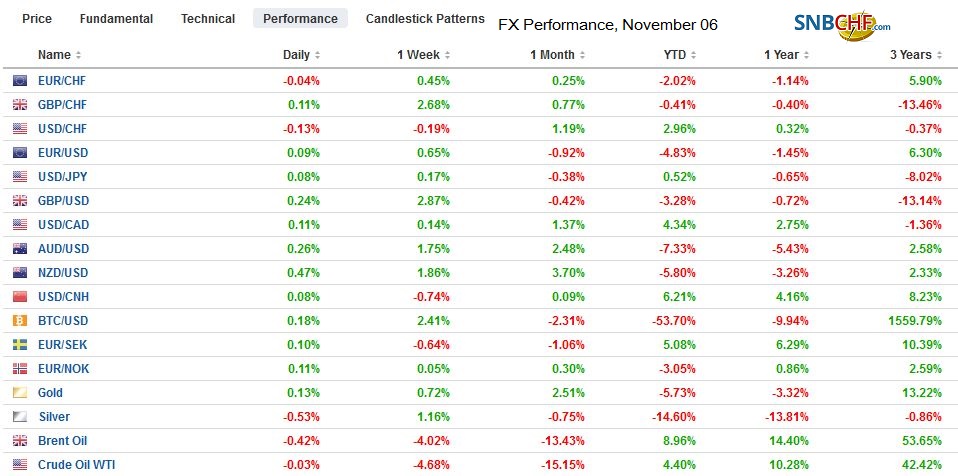Swiss Franc
The Euro has fallen by 0.04% at 1.1452 |
|
FX Rates
Overview: The US dollar is narrowly mixed against the major currencies today, largely consolidating its recent losses. Equities are mixed. In Asia, Japan, Australia, and Hong Kong equities gained around 1%, while most other bourses were softer. In Europe, the Dow Jones Stoxx 600 is little changed in late morning turnover. Ten-year benchmark yields are mostly firmer, with Italy up three basis points, the most in Europe. Although there have been several economic reports today, investors seem mostly sidelined waiting for the US election results and FOMC meeting. |
FX Performance, November 06 - Click to enlarge |
Asia-Pacific: China reported a $16 bln Q3 current account surplus. This follows a $5.3 bln surplus in Q2 and a $34 bln deficit in Q1. This means that through September, China experienced a current account deficit. The current account deficit partly reflects a deterioration in the terms of trade. The price of its imports rose relative to the price of exports. Think about oil and iron ore imports and manufactured goods exports. Also, China’s outbound tourists are picked up as service import. Still, China’s current account, like the US and Germany’s, is driven by the trade account. Other developed countries, like Switzerland and Japan, investment income balance overwhelms the trade balance in the current account calculations.
The yuan is slightly firmer today, and it is off almost 6% this year against the dollar. Although the US Treasury did not find China’s actions reach the threshold of “manipulation” and have not since 1994, Treasury Secretary Mnuchin has said he is open to changing the definition. Why is the yuan weaker against the dollar? Occam’s Razor favors simple explanations. Here’s one that seems under-appreciated: At the start of the year, China’s 10-year onshore yields was 170 bp more than the US. Now it is below 35 bp.
Japan reported a dreadful household spending data for September. Due to the natural disasters, it was accepted that consumption eased from the 2.8% pace in August, which was a three-year high. However, rather than moderate to a 1.5% pace as the median forecast would have had it, it contracted by 1.6%. This increases the chance that the world’s third-largest economy contracted in Q3, as it did in Q1. Early data for Q4 suggests growth returned.
The dollar continues to bump against resistance in the JPY113.35-50 area. The lower end of the recent range is seen near JPY112.50. There is an expiring JPY113.25 option for $620 mln that is in play. There are another nearly $900 mln in options between JPY112.85 and JPY113.00 that also expire today.
The Reserve Bank of Australia met and, as widely anticipated, kept the cash rate at the record low of 1.5%. Growth was upgraded to 3.5% this year and next, while unemployment is expected to ease to 4.75% form 5% over the next two years. Offsetting this was continued concerns about the property markets (especially in Sydney and Melbourne). The Australian dollar is consolidating that the upper end of last week’s range. So far, it is the first session in a month, that the Aussie has not traded below $0.7200.
Europe: The Bundesbank’s recent warning that Europe’s largest economy and the world’s fourth-biggest may have stagnated in Q3 appears to mark the bottom of Germany soft patch. Today, Germany reported a 0.3% increase in factory orders. It was the second increase in a row and only the third of the year, though the increase missed the median forecast for a 0.5% increase. Domestic orders rose 2.8%, and export orders fell 1.4%, which not because of demand from EMU, which saw its orders jump 7.8%.
Germany then reported that both its service PMI and composite PMIs were actually better than the flash readings. This stood in contrast to France where both were revised down. Spain did well with the composite rising to its best level since June. Italy, on the other hand, disappointed. Recall that at the start of the month, the manufacturing PMI fell to 49.2 from 50.0. Today, investors learned that the services PMI also fell to 49.2 (from 53.3). The composite was pulled to 49.3 from 52.1. In the PMI diffusion index, 50 understood to be the threshold between expanding and contracting.
The composite for the PMI for the eurozone improved to 53.1 from the 52.7 flash reading. It is still the lowest since September 2016. It averaged 54.3 in Q3, 54.7 in Q2, and 57.0 in Q1. The euro did not seem to react much to the data. It continues to straddle the $1.1400. Initial support today is seen near $1.1380, where an option for roughly 580 mln euros is set to expire today.
In the UK, the focus is on Prime Minister May’s cabinet meeting to debate once more the latest proposals. It is still not evident how the circle can be squared–how the Tories can accept the concessions the EU is demanding. To some extent, the government is playing the time card. An agreement is thought to be needed within about a week’s time to prepare for a special summit and provide sufficient time for the approval process in time for the end of March exit.
Sterling extended its recent gains toward $1.3085, the highest since October 22, before reversing lower. There is a roughly GBP590 mln option at $1.30 that will be cut today. A break of $1.2950 would likely signal an end of sterling’s recovery from the test on the year’s low at the end of October and the start of November.
North America: The US electorate may be polarized, but two issues that help shape the investment climate on which the two parties seem to find common ground. In terms of fiscal policy, the austere camp is nowhere to be found. The Democrats will most likely not oppose making the household income tax cuts permanent or vigorously resist a Republican proposal to reduce middle-class income taxes. The Democrats advocate an infrastructure initiative. This means that almost regardless of today’s election outcome, the policy mix, which we associate with a stronger currency, of easier fiscal policy and tighter monetary policy will remain intact.
The other issue on which there is bipartisan agreement is that China has gamed the rules and is taking advantage of the United States. After the Kennedy-Johnson era, Democrats were often harangued by Republicans for being “soft on Communism.” The Democrats seem determined to avoid such accusations about China. China appears to be preparing for a protracted engagement with the US. Having thought it had an agreement earlier this year with the US Treasury to dramatically reduce the bilateral surplus by buying more US goods, including agriculture and energy. The reversal of the Administration was a blow to China for which it has not recovered. Trade tensions are likely to persist and have not found the highwater mark yet.
It is likely that shortly after the G20 meeting that Trump and Xi will meet, Trump will begin the process to impose 10% tariffs on the remaining $255 bln of goods or so that have not been hit yet. There are several places along the process that can be used to stall or halt the momentum before implementation, but the modus operandi is to maintain maximum pressure (see North Korea, Canada, Mexico). The 10% tariff on $200 bln Chinese goods is raised to 25% on January 1.
Canada reports September building permits today, and October housing starts on Thursday. The Canadian dollar is trading quietly in narrow ranges. Implied (three-month) volatility is near the lower end of its 4-5 month range of roughly 6.5% to about 7.7%, which could make for attractive hedging opportunities. The premium the US offers over Canadian rates has also edged lower. Broadly speaking the US dollar has been largely confined to a CAD1.28-CAD1.32 range for several months. It is trading near the upper end of the range, but the technical indicators suggest caution in playing for a breakout.
Graphs and additional information on Swiss Franc by the snbchf team.
Full story here
Are you the author?
He has been covering the global capital markets in one fashion or another for more than 30 years, working at economic consulting firms and global investment banks. After 14 years as the global head of currency strategy for Brown Brothers Harriman, Chandler joined Bannockburn Global Forex, as a managing partner and chief markets strategist as of October 1, 2018.
Previous post
See more for 4.) Marc to Market
Next post
Tags:
#GBP,
#USD,
$AUD,
$CAD,
$CNY,
$EUR,
$JPY,
EUR/CHF,
newsletter,
USD/CHF
























